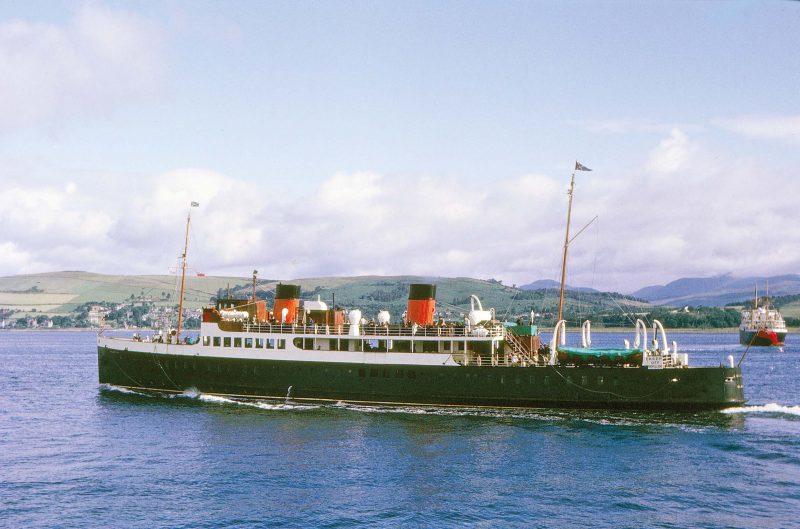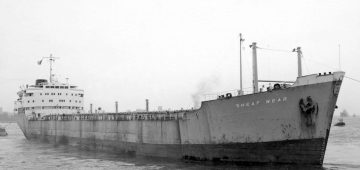By Willie Watson
As 3rd engineer aboard the DEV Lochfyne
It was the middle of July 1967 and I was sitting at home reading the Glasgow newspapers. I had signed off articles on the 27th of June in the Royal Docks, London. I had been 6th engineer aboard the NZSCo. motor liner RMS Ruahine and had returned after a voyage out to NZ on the London-Wellington service via Panama. I had been home for a couple of weeks. Home was Atlantic House, the Glasgow sailors home, at 47 York St., Glasgow C2 – my parents managed the place. It was just off Argyle St.
My marriage was looming and I did not want to sign on for another deep sea voyage (yet) but wanted a job for a month or two.
While reading the vacancies/jobs column in the Glasgow Herald I read stand-by 3rd engineer required apply at the office of David MacBrayne, Robertson St., Glasgow C2. This was luck indeed as Robertson St. was the next Street east of York Street and only a 5 minute walk away from my home. Both streets ran parallel to the river Clyde near the Anderston area. The next morning I walked around to the David MacBrayne office taking my testimonials from NZSCo and my discharge book No. R 843260, and after a short interview, I was told that I had been given the job and it would be aboard the vessel Lochfyne berthed at Greenock. Her destination at that time was unknown by me. David Macbrayne was a Highlands & Islands ferry service company and I imagined myself in Stornoway Barra or Mingulay. The job would be for approximately six weeks while I replaced the ships 3rd engineer who was going out to Australia to stay with family. I signed on as 3rd engineer aboard the DEV Lochfyne on the 31st July 1967 at Greenock. I was up at 6am that day to get the 7am train for the 40-50 minute journey to Greenock and then a 10 minute walk to the harbour and the ship. I had taken all my deep sea gear with me not imagining that I would be lugging it all the way back to Glasgow the same day. I did not know then that the ship left Greenock at 8.30am each day and returned at 5.30pm the same day – six days a week (Mon-Sat)!

The little ship was a diesel electric vessel of 754grt built by Wm. Denny of Dumbarton in 1931. Her main engines (generators) were 6 cylinder British Polar 4-stroke diesel and ran at 600rpm feeding the power to the ship’s main electrical switchboard then on to the main driving motors that were directly coupled to the propeller shafts on this twin screw ship. At full speed the shafts ran at 380-400 rpm. These main engines also supplied the rest of the ship’s electrical requirements via the switchboard while underway. When not underway there was a stand-by 6 cylinder Gardner diesel generator to power the ship’s services prior to going over to shore supply electricity at the end of the working day (this was part of my job). There was also a Sharples diesel oil purifier/separator used to clean the diesel fuel oil used on the main engines and stand-by generator before going to the D.O. service tank.

Officers were allowed to take their meals in the passengers dining saloon and over breakfast I met the rest of the engineers the 2nd engineer Andy lived at Oban, the 4th engineer Pat at Port Glasgow, and the 5th engineer Dougie at Port Ellen on the Isle of Islay. We had lunch at noon up at Ardrishaig and afternoon tea around 4pm on the homeward leg 6 days a week three meals a day for 24 shillings and six pence, £1.25p in new money!
Leaving Greenock the first port of call was Gourock here a fair amount of passengers cargo and mail came aboard then it was across the firth to Dunoon (Argyle) and then Rothesay (Isle of Bute). Leaving Rothesay the little ship would enter the Kyles of Bute and on approaching the narrows at Colintraive with the narrow deep dark and foreboding Loch Riddon to starboard, would turn to port calling at Tighnabruaich. Leaving Tighnabruaich and entering the Sound of Bute the ship would then turn to starboard rounding Ardlamont Point and enter Lochfyne, the Loch she was named after. The next port of call was Tarbert and finally Ardrishaig. Here I would start the Gardner stand-by generator and shut down the main engines as the ship would be here for a little over an hour. The same ports of call would be called at, in reverse, on the homeward run. The memories came fast and thick for as a schoolboy in the mid 1950s. I often sailed this route on the famous Clyde turbine steamer Queen Mary II sailing from Bridge Wharf, Glasgow opposite the Broomielaw, but only as far as Tighnabruaich and then back to Glasgow. There were many ferries still criss-crossing those waters that were familiar to me. The car/passenger ferries Cowal, Arran and Bute as well as the smaller passenger ferries Maid of Ashton, Maid of Skelmorlie, and Countess of Bredalbane.
One day I noticed that the main air receiver for starting the main engines was not holding pressure (400psi). This I traced to a leaking drain valve on the bottom of the receiver. The only way to fix this was to de-pressurise and drain down the receiver and remove the valve. I had to go up and tell the captain that he would not be able to use the ship’s whistle as there would be no air for it for a while. The job went well and the old man had his air back in a couple of hours.
The Lochfyne arrived back at Greenock just after 5pm. Here I would shut down the main engines and other auxiliary machinery jump ashore and switch over to shore supply electricity and connect the hoses for the shore supply of fresh water, leaving the ship most evenings around 5.30pm for the train back to Glasgow. Atlantic House was only a short walk from Glasgow Central Station and I would get home at around 6.30pm.
Most evenings I would leave the little ship, however I remember one particular day in August. It had been the most beautiful day of summer on the Clyde and I decided to remain aboard for the night as there were bunks in the forward part of the ship. I walked up to the Seamans Mission in the town for something to eat returning to the ship in the late evening. I was up on deck having a smoke and enjoying the late evening sun when down the river in the charge of two tugs came a sight to behold. She was the almost new Blue Funnel cargo liner MV Protesilaus of the Priam Class, very similar to the Glen Almond class of GlenLine. These I believe were some of the last of the conventional British cargo liners before containerisation. They were beautiful ships!


I signed off the Lochfyne on the 16th September 1967 and was married in South Devon the following month, then went back deep sea sailing for a couple of years with Blue Star Line as an engineer aboard the Fremantle Star.



Comments
Sorry, comments are closed for this item